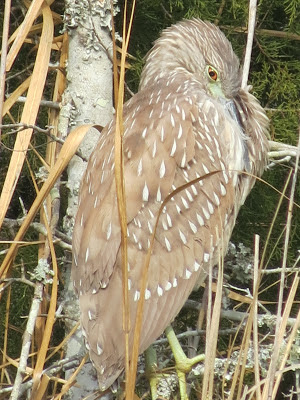Happy New Year! I hope you have many enjoyable nature outings and adventures in 2013.
We are fortunate in South Carolina to have several wildlife refuges in the state's Lowcountry. Several are former rice plantations located in the ACE basin. This is a large protected region named for the confluence of three rivers, the Ashepoo, Combahee and Edisto.
I've posted previously on some of the other locations that are part of this system: Bear Island and the Hollings National Wildlife Refuge, for example. The other day Alesia and I drove down to the Donnelley Wildlife Management Area (WMA) in remote Green Pond, S.C.

We are fortunate in South Carolina to have several wildlife refuges in the state's Lowcountry. Several are former rice plantations located in the ACE basin. This is a large protected region named for the confluence of three rivers, the Ashepoo, Combahee and Edisto.
I've posted previously on some of the other locations that are part of this system: Bear Island and the Hollings National Wildlife Refuge, for example. The other day Alesia and I drove down to the Donnelley Wildlife Management Area (WMA) in remote Green Pond, S.C.
I had been to Donnelley a few times before. This was the first time in the winter, and it proved to be the best as far as the abundance of birds. We first saw a number of Common Moorhens in a swamp a short ways from the entrance to the 8,000 acre preserve. Whatbird.com describes the Moorhens as a chicken-like marsh bird distinguished by the red shield-like plate above its bill. It also has a distinctive yellow tip on its bill.
Donnelley has a large pond that, on this day, had a nice variety of birds in and around it, including these Great Blue Herons. This large bird, always so photogenic and picturesque, was especially so with the neat reflections and when they passed or stood near each other.
This next shot looks like it was done in time elapsed exposure. It wasn't. It's two Great Blue Herons and a neat reflection.
On a small island there were a number of Black-crowned Night Herons, many of which seemed to be in slumber mode.
We tried to be quiet so as to not wake or disturb them!
The juvenile of this species looks so different than the adults. What a beautiful plummage and eye coloring the young ones have!
I also liked this pair of Boat-tailed Grackles. They were very busy with lots of calling and keeping their bills to the sky.
These Grackles earned their boat-tailed name from their long, keel-shaped tails. I have seen these birds before but never when the blue-black body was as indescent as this.
I was also excited to see this Northern Flicker, a member of the Woodpecker family. I have seen this bird only once before, at Charleston's Magnolia Cemetery. I recognized the black crescent on its breast. The red on its head indicates that this is a male.
I noticed a spot of yellow on this bird's tail. See it? My research later found that the Northern Flicker has a yellow-shafted race and a red-shafted race. In this photo, the Flicker's head is turned away from me. You really see the male's red head marking.
The Northern Flicker was a really neat bird to see on this day!
It was also a treat to see some Bald Eagles!
I didn't get the sharpest images of the adult or the juvenile Bald-Eagle, which we saw from two different spots at Donnelley.

This was a "lifer" sighting for me! I cannot recall ever seeing a juvenile Bald Eagle before in the wild like this! I've seen the adults occasionally over the years on nature outings. Alesia was especially thrilled by our eagle encounter.
We also saw a juvy swoop down into the pond after some prey, but it came up empty handed. Note the Great Blue Heron in the background.
It's hard to make out clearly but I'm pretty sure this is the same juvenile Bald Eagle seen above minutes later taking a rest on a branch overlooking the pond.
Here are a few other birds we spotted at the Donnelley wildlife area. Below, a lovely Snowy Egret with its distinctive yellow "slippers" and dark bill (Great Egrets have yellow bills).
On a powerline over a field I spotted this Brown-headed Cowbird.
A pair of Eastern Bluebirds were also on nearby powerlines.
Belted Kingfishers, one of my favorite birds, were also in this area. We saw them in a couple different places and I was able to get some nice shots of this often very elusive (to humans with cameras) bird!
I photographed another Belted Kingfisher on one of the many rice field wooden trunks. These structures are used today, as they were in the heyday of rice cultivation, to control the flow of water in and out of fields.
A Northern Mockingbird was nearby along this path.
We also saw a posse (or raffle) of Wild Turkeys.
This was an unsual sighting also: Gray Fox Squirrels
I've seen this type of Southern Fox Squirrel at some of the other ACE Basin wildlife refuges. This was the first time I got pictures of the wiry, fast moving (though sometimes still) critter.
As we were leaving the area we stopped at a gate opening to this trail that is part of the Bear Island WMA, which is closed for hunting until February. I like this tree!
On the way home I had to stop and photograph this fishing lure mailbox. How creative and well designed too.
Owner of this mailbox- I like your style!





























No comments:
Post a Comment